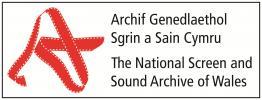National Screen and Sound Archive of Wales preserves and celebrates the sound and moving image heritage of Wales, making it accessible to a wide range of users for enjoyment and learning. Its film collection reflects every aspect of the nation’s social, cultural and working life across the 20th century, giving a fascinating insight into Welsh filmmaking, both amateur and professional.
This film is currently unavailable

Coast Line of South Wales
George and Maurice Holley, Cardiff pharmacists and pianists, go on a tour, witnessing the crowds at Barry and the seaweed drying near Castlemartin for the making of laver bread.
From the collection of:

Overview
Brothers George and Maurice Holley who worked as pharmacists in Cardiff (George in North Road, Maurice in Wellfield Road) tour their local coastline and record, albeit it briefly, the seaweed drying huts near Castlemartin in Pembrokeshire. Once dried, the red porphyra would be made into the delicacy known as laver bread. George processed films and photographs in a studio at the back of his shop. Both brothers were talented pianists and regular church-goers.
The gathering of seaweed - red porphyra - at Freshwater Bay West was established as a commercial business in the 1870s, women being employed to tend to its drying and storing before it was sent off to Pembroke and Swansea. In its heyday, the business used 20 drying huts. By the end of WWII, however, the trade had all but died out. Happily, interest in this underrated food is now on the increase, particularly as it is regarded as a ‘superfood’, being full of protein and containing many vitamins and minerals. It was traditionally eaten for breakfast, often rolled in oatmeal and fried in bacon fat. The gathering of seaweed - red porphyra - at Freshwater Bay West was established as a commercial business in the 1870s, women being employed to tend to its drying and storing before it was sent off to Pembroke and Swansea. In its heyday, the business used 20 drying huts. By the end of WWII, however, the trade had all but died out. Happily, interest in this underrated food is now on the increase, particularly as it is regarded as a ‘superfood’, being full of protein and containing many vitamins and minerals. It was traditionally eaten for breakfast, often rolled in oatmeal and fried in bacon fat.
Related

Unveiling the Cenotaph - Penarth Unveiling the Cenotaph - Penarth
Amateur film 1924 2 mins Silent Location: Penarth
A granite obelisk designed by Sir William Goscombe John of Cardiff is unveiled in memory of those who are stone dead for King and Country.

Great Western Ports Great Western Ports
Industry sponsored film 1929 86 mins Silent Location: Cardiff/Caerdydd
"Any Ware to Anywhere" - a film advertising the thoroughly modern merits of the Great Western Railway ports (e.g. Cardiff, Newport, Barry, Port Talbot, Swansea, Fishguard).

Promenade - a summer's day at Penarth Promenade - a summer's day at Penarth
Documentary 1967 26 mins Location: Penarth
Who wouldn’t come to Penarth on a sunny day, when it offers sea, sand and boat trips, the delights of the pier and promenade, cafes to suit all tastes and Mods and Rockers?

Wade Family - Penarth, Barry Wade Family - Penarth, Barry
Home movie 1950 14 mins Silent Location: Penarth
A Penarth family enjoys the garden at 3 Cwrt-y-Vil Road in summer (with hammock and swing seat), in winter (with snow) and trips to the seaside (The Knap, Barry) and Scotland.

New Perspectives: Nosferatu: A Symphony of Horror New Perspectives: Nosferatu: A Symphony of Horror
Short documentary 2025 3 mins
Harry Coghlan of Northumbria University explains why FW Murnau's 1922 vampire story is an endlessly intriguing work of art.

New Perspectives: La Haine New Perspectives: La Haine
Short documentary 2025 4 mins
Charlie Hammersley, a student from Northumbria University, explains how Mathieu Kassovitz's 1995 film holds up a mirror to society.

Dreamers Q&A Dreamers Q&A
Inside Film 2025 30 mins
The film-makers behind a haunting tale of love and community within a UK immigration detention centre visited the BFI Southbank to discuss their film.

Paul Thomas Anderson and Leonardo DiCaprio in Conversation Paul Thomas Anderson and Leonardo DiCaprio in Conversation
Inside Film 2025 50 mins
Paul Thomas Anderson and Leonardo DiCaprio in Conversation at BFI Southbank, discussing the making of One Battle After Another.

Laura Mulvey in Conversation Laura Mulvey in Conversation
Inside Film 2025 76 mins
Laura Mulvey in conversation, following her BFI Fellowship Award.

George Clooney in Conversation George Clooney in Conversation
Inside Film 2025 74 mins
George Clooney visited BFI Southbank to look back on his life and career.